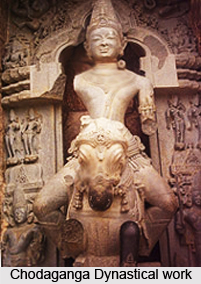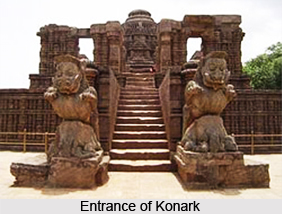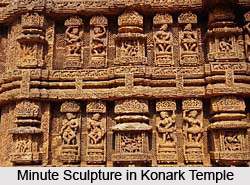 Konark Temple has been known for the supreme achievement of the architectural genius of Odisha. Situated about 20 miles northeast of Puri in Odisha, this temple is a result of the continuous development for centuries. The temple was built, during the reign of the eastern Ganga King Narasimha Deva I (1238-1264). The name of the place `Konark` is derived from Konarka, the presiding deity of the Sun Temple. The temple is dedicated to the Sun God and its entire appearance is conceived of as a rath, giving the name `Temple on Wheels`. The entire temple is designed to achieve the shape of a colossal chariot with seven horses and twenty-four wheels, for the Sun God, carrying him across the heavens.
Konark Temple has been known for the supreme achievement of the architectural genius of Odisha. Situated about 20 miles northeast of Puri in Odisha, this temple is a result of the continuous development for centuries. The temple was built, during the reign of the eastern Ganga King Narasimha Deva I (1238-1264). The name of the place `Konark` is derived from Konarka, the presiding deity of the Sun Temple. The temple is dedicated to the Sun God and its entire appearance is conceived of as a rath, giving the name `Temple on Wheels`. The entire temple is designed to achieve the shape of a colossal chariot with seven horses and twenty-four wheels, for the Sun God, carrying him across the heavens.
History of Konark Temple
The current temple is attributed to Narasimhadeva I of the Eastern Ganga Dynasty, 1238–1264 CE. It is one of the few Hindu temples whose planning and construction records written in Sanskrit in the Odiya script have been preserved in the form of palm leaf manuscripts that were discovered in a village in the 1960s and subsequently translated. The temple was sponsored by the king, and its construction was overseen by Siva Samantaraya Mahapatra. It was built near an old Surya temple. The sculpture in the older temple`s sanctum was re-consecrated and incorporated into the newer larger temple. This chronology of temple site`s evolution is supported by many copper plate inscriptions of the era in which the Konark temple is referred to as the "great cottage".
The temple was built in the 13th century. It consisted of two main structures, the dance mandapa and the great temple (deul). The smaller mandapa is the structure that survives. The great deul collapsed sometime in the late 16th century or after.
Architecture of Konark Temple
The base of the temple is formed with an immense terrace with twenty-four giant wheels; each one is around 10 feet high, on either side. Therefore, the temple is constructed on the raised platform and the actual temple building is erected in two conjoined parts. The natmandir and the bhogmandir are constructed as separate structures, but enclosed within a courtyard measuring 865 ft. by 540 ft. The masterpieces of Hindu art show the presence of Hindu God and Goddess in its expressions. The carving with minute details and attributions of them can be said as the characteristic of the art.
 The temple is known for its impressive Kalinga architecture that includes a depiction of a 100 ft high chariot being pulled by horses and wheels carved out of a single stone. The monument portrays the imposing chariot of the Sun God. Built of Khondalite rocks, the original temple had 230 ft high sanctum which no longer exists, 128 ft high audience hall, dance hall, dining hall which still survive. There are 24 intricately designed wheels, 12 ft in diameter which are seen drawn by horses. These seven horses represent the week, the wheels stand for the 12 months while the day-cycle is symbolized by the eight spokes in the wheels. And this whole depiction tells how the time is controlled by the Sun – being the very illustration of the Surya in the Hindu mythology travelling from the east in his chariot escorted by his charioteer, Aruna.
The temple is known for its impressive Kalinga architecture that includes a depiction of a 100 ft high chariot being pulled by horses and wheels carved out of a single stone. The monument portrays the imposing chariot of the Sun God. Built of Khondalite rocks, the original temple had 230 ft high sanctum which no longer exists, 128 ft high audience hall, dance hall, dining hall which still survive. There are 24 intricately designed wheels, 12 ft in diameter which are seen drawn by horses. These seven horses represent the week, the wheels stand for the 12 months while the day-cycle is symbolized by the eight spokes in the wheels. And this whole depiction tells how the time is controlled by the Sun – being the very illustration of the Surya in the Hindu mythology travelling from the east in his chariot escorted by his charioteer, Aruna.
The entrance leads to the shrine of the deity of Surya made of chlorite stone. The walls of the temple are adorned with reliefs – intricate carvings of various figures including Hindu gods, images of the everyday mortal life, birds, animals and more. The temple also has erotic sculptures on its shikhara belonging to the tantra tradition. The wheels of the temple can be used as sundials and can well predict the time.
Sculptures in Konark Sun Temple
The excellent appearance and vitality of the structure is due to the roof in pyramidal style with its three tiers and sculptured figures. The sculpture that embellishes the outer surfaces of this architectural masterpiece is equally exquisite in its luxuriance and also employs many techniques of invention than the vast structure itself. The exterior part of the temple structure is chiseled and molded with either using abstract designs, or fantastic human and animal forms. The sculptors have tried their best to use every motif and subject known to the Indian mind in the theme of carvings.
The walls of the temple from the base through the crowning elements are ornamented with reliefs, many finished to jewelry-quality miniature details. The terraces contain stone statues of male and female musicians holding various musical instruments including the veena, mardala, gini, etc. Other major works of art include sculptures of Hindu deities, apsaras and images from the daily life and culture of the people (artha and dharma scenes), various animals, aquatic creatures, birds, legendary creatures, and friezes narrating the Hindu texts. The carvings include purely decorative geometric patterns and plant motifs. Some panels show images from the life of the king such as one showing him receiving counsel from a guru, where the artists symbolically portrayed the king as much smaller than the guru, with the king`s sword resting on the ground next to him.
 The upana (moulding) layer at the bottom of the platform contains friezes of elephants, marching soldiers, musicians, and images depicting the secular life of the people, including hunting scenes, a caravan of domesticated animals, people carrying supplies on their head or with the help of a bullock cart, travelers preparing a meal along the roadside, and festive processions. On other walls are found images depicting the daily life of the elite as well as the common people. For example, girls are shown wringing their wet hair, standing by a tree, looking from a window, playing with pets, putting on makeup while looking into a mirror, playing musical instruments such as the veena, chasing away a monkey who is trying to snatch items, a family taking leave of their elderly grandmother who seems dressed for a pilgrimage, a mother blessing her son, a teacher with students, a yogi during a standing asana, a warrior being greeted with a namaste, a mother with her child, an old woman with a walking stick and a bowl in her hands, comical characters, are among others.
The upana (moulding) layer at the bottom of the platform contains friezes of elephants, marching soldiers, musicians, and images depicting the secular life of the people, including hunting scenes, a caravan of domesticated animals, people carrying supplies on their head or with the help of a bullock cart, travelers preparing a meal along the roadside, and festive processions. On other walls are found images depicting the daily life of the elite as well as the common people. For example, girls are shown wringing their wet hair, standing by a tree, looking from a window, playing with pets, putting on makeup while looking into a mirror, playing musical instruments such as the veena, chasing away a monkey who is trying to snatch items, a family taking leave of their elderly grandmother who seems dressed for a pilgrimage, a mother blessing her son, a teacher with students, a yogi during a standing asana, a warrior being greeted with a namaste, a mother with her child, an old woman with a walking stick and a bowl in her hands, comical characters, are among others.
The Konark temple is known for its erotic sculptures of maithunas. These show couples in various stages of courtship and intimacy, and in some cases coital themes. Notorious in the colonial era for their uninhibited celebration of sexuality, these images are included with other aspects of human life as well as deities that are typically associated with tantra. This led some to propose that the erotic sculptures are linked to the vama marga (left hand tantra) tradition. However, this is not supported by local literary sources, and these images may be the same kama and mithuna scenes found integrated into the art of many Hindu temples. The erotic sculptures are found on the temple`s Shikhara, and these illustrate all the bandhas (mudra forms) described in the Kamasutra.
The massive structure of the temple, though now in ruins, sits in solitary splendor surrounded by the drifting sands. The huge wheels carved with intricate design of the rathas are the major attractions in the entire architecture of the place. The spikes of these huge and artistic wheels serve as sundials and with the help of the shadows formed by these wheels, one can be informed with the precise time of the day. The pyramidal roof of the temple adds in the glory of the architectural beauty. The roof is made from the sandstone and soars over 30 m in height. The sculptures carved on walls of the temple is accompanying a brilliant chronicle in stone, with thousands of images including deities, the surasundaris, which were known as heavenly damsels, and human musicians, lovers, dancers, etc. It also depicts different scenes that reveal around the courtly life.



